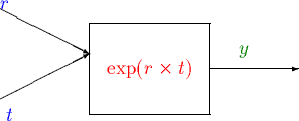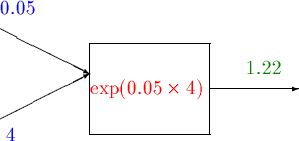
Later in the course we will study continuous compounding, which among other things can be used to describe how money grows over time. If one dollar is initially invested, then at a later date, say t years in the future, if the interest rate is r, it grows according to the rule
Money at time t equals exp(r t), where exp stands for the exponential function.
This relationship can be represented graphically as

Suppose the interest rate is 5%, and that the dollar is invested for 4 years, then r = 0.05 and t=4 giving

Symbolically we write
which displays the fact the the value of the investment, y, depends on two quantities, r the interest rate and t, the length of time that the investment is held.